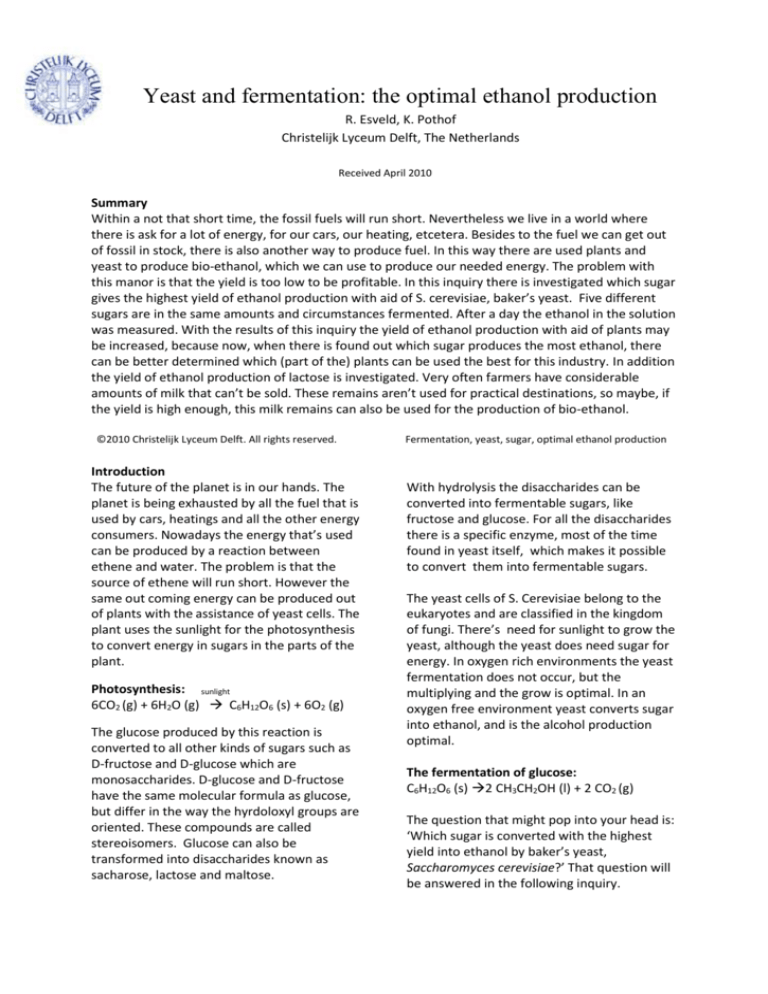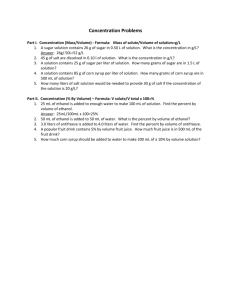
Yeast and fermentation: the optimal ethanol production
R. Esveld, K. Pothof
Christelijk Lyceum Delft, The Netherlands
Received April 2010
Summary
Within a not that short time, the fossil fuels will run short. Nevertheless we live in a world where
there is ask for a lot of energy, for our cars, our heating, etcetera. Besides to the fuel we can get out
of fossil in stock, there is also another way to produce fuel. In this way there are used plants and
yeast to produce bio-ethanol, which we can use to produce our needed energy. The problem with
this manor is that the yield is too low to be profitable. In this inquiry there is investigated which sugar
gives the highest yield of ethanol production with aid of S. cerevisiae, baker’s yeast. Five different
sugars are in the same amounts and circumstances fermented. After a day the ethanol in the solution
was measured. With the results of this inquiry the yield of ethanol production with aid of plants may
be increased, because now, when there is found out which sugar produces the most ethanol, there
can be better determined which (part of the) plants can be used the best for this industry. In addition
the yield of ethanol production of lactose is investigated. Very often farmers have considerable
amounts of milk that can’t be sold. These remains aren’t used for practical destinations, so maybe, if
the yield is high enough, this milk remains can also be used for the production of bio-ethanol.
©2010 Christelijk Lyceum Delft. All rights reserved.
Introduction
The future of the planet is in our hands. The
planet is being exhausted by all the fuel that is
used by cars, heatings and all the other energy
consumers. Nowadays the energy that’s used
can be produced by a reaction between
ethene and water. The problem is that the
source of ethene will run short. However the
same out coming energy can be produced out
of plants with the assistance of yeast cells. The
plant uses the sunlight for the photosynthesis
to convert energy in sugars in the parts of the
plant.
Photosynthesis: sunlight
6CO2 (g) + 6H2O (g) C6H12O6 (s) + 6O2 (g)
The glucose produced by this reaction is
converted to all other kinds of sugars such as
D-fructose and D-glucose which are
monosaccharides. D-glucose and D-fructose
have the same molecular formula as glucose,
but differ in the way the hyrdoloxyl groups are
oriented. These compounds are called
stereoisomers. Glucose can also be
transformed into disaccharides known as
sacharose, lactose and maltose.
Fermentation, yeast, sugar, optimal ethanol production
With hydrolysis the disaccharides can be
converted into fermentable sugars, like
fructose and glucose. For all the disaccharides
there is a specific enzyme, most of the time
found in yeast itself, which makes it possible
to convert them into fermentable sugars.
The yeast cells of S. Cerevisiae belong to the
eukaryotes and are classified in the kingdom
of fungi. There’s need for sunlight to grow the
yeast, although the yeast does need sugar for
energy. In oxygen rich environments the yeast
fermentation does not occur, but the
multiplying and the grow is optimal. In an
oxygen free environment yeast converts sugar
into ethanol, and is the alcohol production
optimal.
The fermentation of glucose:
C6H12O6 (s) 2 CH3CH2OH (l) + 2 CO2 (g)
The question that might pop into your head is:
‘Which sugar is converted with the highest
yield into ethanol by baker’s yeast,
Saccharomyces cerevisiae?’ That question will
be answered in the following inquiry.
Our hypothesis is that glucose will be the best
candidate because all the other sugars are
derived from glucose. All the other sugars
need an intermediate step before they can be
fermented and therefore they are less
productive.
With the results of the inquiry there might be
estimated which part of the plant or which
sort plant is the most suitable for the
production of bio-ethanol, when the amounts
of the different sugars in (the parts of) the
plant are known.
Experimental procedure and approach
Starting with an 18 Volume-% of Fructose,
Glucose, Lactose, Maltose and Sacharose
solution in five flasks, from every flask there
was taken 10 ml of every solution and put that
into five Erlenmeyers, one for every sugar.
There was taken 5 gram yeast and added to
every Erlenmeyer with the five different
sugars. The Erlenmeyers were being covered
with plastic foil and were put aside for a day.
In addition there was made a 0,05 M
potessiumdichromate-solution in a flask. After
a day the solutions were filtered and most of
the yeast cells were gone.
there was determined the absorption and the
percent transmission in addition with the
results the amount of ethanol in the filtrates
could be determined.
nm
(wavelenght)
440
470
490
520
550
580
590
680
1 (yellow)
2 (green)
0,71
0,54
0,25
0,07
0,03
0
0
0
0
0
0
0,01
0,05
0,08
0,07
0,05
Volume-%
0
2
4
6
8
10
Absorption
0
0,04
0,07
0,08
0,11
0,11
% Transmission
100
91
85
83
77
78
Table 2
y-as=%transmission, x-as= vol-% ethanol
Table 1
Figure 1
Therefore it was possible to measure the
amount of ethanol in the filtrate with the help
of the potessiumdichromate-solution,
sulphuric acid and a photospectrometer. The
measurements took place by a wavelength of
580 nm, since that was the wavelength with
the biggest difference in outcome for the color
green (which was used).
The photospectrometer measured in
absorption or percent of transmission. To
convert this into an amount of ethanol, there
was made a calibration diagram (graphically
presented beneath in figure one and two)
with ethanol solutions of 0,0; 2,0; 4,0; 6,0; 8,0;
10 Volume-%. From this different solutions
y-as=absorption, x-as= vol-% ethanol
Figure 2
*The cold versions of the solutions were for the calibration for
Results
The difference in absorption or transmission
between the five sugars is shown in the table
below. This difference in absorption or in
transmission is proportional with the
produced ethanol from each sugar. The sugar
with the highest absorption or transmission, is
the sugar that is converted with the highest
yield into ethanol.
Conclusion and discussion
As shown in Table 3, the alcohol production
was the highest with the monosaccharide
sugar called glucose, that was accurate with
the hypothesis. Also there is shown that
lactose has, in comparison with the other
sugars, a lower yield of conversion into
ethanol. Lactose may be a not a good option
for the production of bio-ethanol, because of
this low yield.
However, in the experiment there were some
points of discussion. Foremost that the
equipment which was used to measure the
amounts of all the elements that was used
was not always that significant. Moreover it
was all executed by human beings and in
addition there weren’t always small enough
pipettes. The next point of discussion is that
the temperature in the room wasn’t always
constant and the whole experiment was
completed in a classroom, which sometimes
may have sun on the windows that makes it
warmer inside. This might have influenced our
results. Looking critically at our experimental
procedure and approach we see that in all sets
of experiments we considered the same
independent and dependent variables and we
kept the same variables constant.
HOI
Sugars
Absorption
% Transmission
Fructose
cold
hot
Lactose
cold
hot
Glucose
cold
hot
Maltose
cold
hot
Sacharose cold
hot
0
100
0,06
86
0
100
0,05
89
0
100
0,08
84
0
100
0,06
88
0
100
0,07
86
the next measurement. EN RENSKE AAAHHAHAH
LOL IS DIT HAAAIAI
AJAJJDJDNDNDNDNDNDKLKKKKXDDKDXDXDX
Bibliography
Dickinson, J. R. (1999). Carbon metabolism.
In: The Metabolism and Molecular
Physiology of Saccharomyces cerevisiae
http://en.wikipedia.org/wiki/Ethanol_ferme
ntation
David B. Fankhauser, Ph.D.,
Professor of Biology and Chemistry
University of Cincinnati Clermont College:
Spectrophotometer use,
http://biology.clc.uc.edu/fankhauser/Labs/M
icrobiology/Growth_Curve/Spectrophotomet
er.htm








